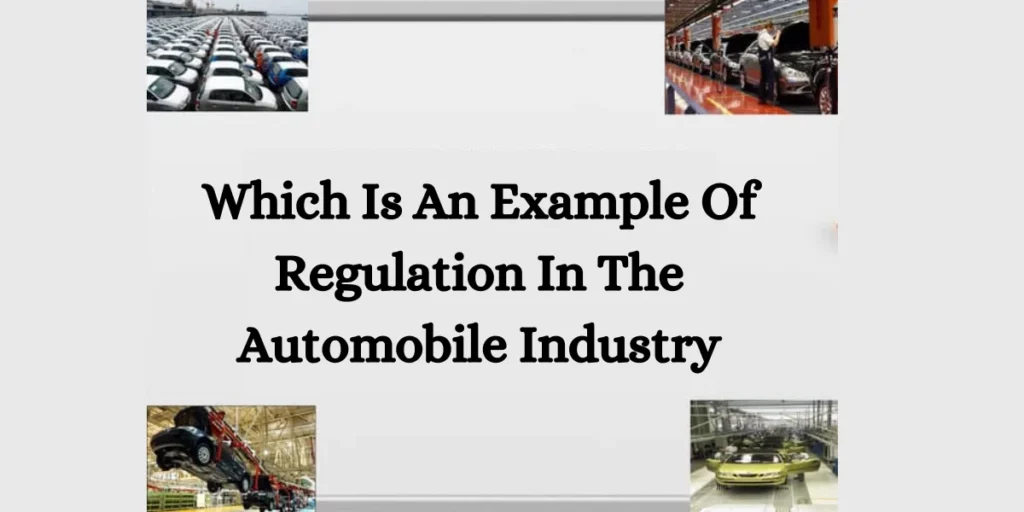Which Is An Example Of Regulation In The Automobile Industry
The automobile industry, a cornerstone of modern society, has evolved significantly over the years. With this evolution, the need for regulations to ensure safety, environmental sustainability, and fair competition has become paramount. This article delves into notable examples of regulations within the automobile industry that shape the way vehicles are manufactured, marketed, and operated.
Safety Standards: Protecting Lives on the Road
Safety remains a paramount concern in the automobile industry, leading to the establishment of stringent safety standards. These standards, often enforced by government agencies, ensure that vehicles meet certain criteria for crashworthiness, occupant protection, and overall road safety. For instance, the National Highway Traffic Safety Administration (NHTSA) in the United States mandates safety features like airbags, seat belts, and electronic stability control in all new vehicles. This not only safeguards drivers and passengers but also influences manufacturers to innovate in vehicle design and engineering.
Emissions Regulations: Driving Towards Environmental Sustainability
The environmental impact of the automobile industry has spurred regulatory efforts to mitigate emissions. Stricter emissions standards have led to advancements in technology, such as catalytic converters and cleaner fuel options. The European Union’s emission standards, categorized as Euro 1 through Euro 6, progressively limit pollutants like nitrogen oxides (NOx) and particulate matter (PM) from vehicle exhausts. These regulations have prompted manufacturers to develop eco-friendly solutions, including hybrid and electric vehicles, steering the industry towards a greener future.
Fuel Efficiency Requirements: Balancing Performance and Economy
As concerns about energy conservation grew, fuel efficiency regulations emerged to address the balance between vehicle performance and economic consumption. The Corporate Average Fuel Economy (CAFE) standards in the United States set targets for the average fuel efficiency of manufacturers’ fleets. This encourages automakers to invest in research and development to produce vehicles that consume less fuel, reducing both operational costs for consumers and the industry’s overall carbon footprint.

Consumer Protection Laws: Empowering Vehicle Buyers
Consumer protection laws play a vital role in ensuring fair business practices within the automobile industry. These regulations encompass various aspects, including accurate advertising, warranty coverage, and disclosure of relevant vehicle information. The Magnuson-Moss Warranty Act in the U.S. protects consumers by requiring clear and concise explanations of warranty terms. Such laws empower buyers with the information needed to make informed decisions, fostering trust between consumers and manufacturers.
Intellectual Property Rights: Fostering Innovation
Innovation drives progress in the automobile industry, and regulations surrounding intellectual property rights safeguard the fruits of innovation. Patents, copyrights, and trademarks protect the unique designs, technologies, and branding associated with vehicles. This encourages manufacturers to invest in research and development without the fear of ideas being exploited by competitors. Robust protection of intellectual property fosters healthy competition, benefiting consumers by bringing novel and improved products to the market.
Global Harmonization: Standardizing Regulations
The automobile industry is global, with vehicles and components often crossing borders. To facilitate international trade and ensure consistent safety and environmental standards, efforts towards regulatory harmonization have gained momentum. Organizations like the United Nations Economic Commission for Europe (UNECE) formulate regulations such as the World Forum for Harmonization of Vehicle Regulations (WP.29). These agreements streamline standards across countries, reducing complexities for manufacturers and benefiting consumers worldwide.
Navigating the Regulatory Roadmap
Regulations in the automobile industry are not merely bureaucratic hurdles; they are the threads that weave safety, environmental consciousness, fair practices, and innovation into the fabric of the automotive landscape. From safety standards that shield lives to emissions regulations that combat pollution, these rules shape the industry’s trajectory. By understanding and embracing these regulations, manufacturers, consumers, and the environment can collectively steer the automobile industry towards a more secure, sustainable, and innovative future.
Abu Mansoor Plastic Factory:
Abu Mansoor Plastic Factory is a prominent player in the plastic manufacturing sector. With a focus on quality and innovation, the factory produces a wide range of plastic products, contributing to diverse industries globally.
Emirates Industrial Gases:
Emirates Industrial Gases stands as a leading provider of industrial and medical gases. Their commitment to precision and reliability has made them a key partner for industries requiring gases for various applications.



